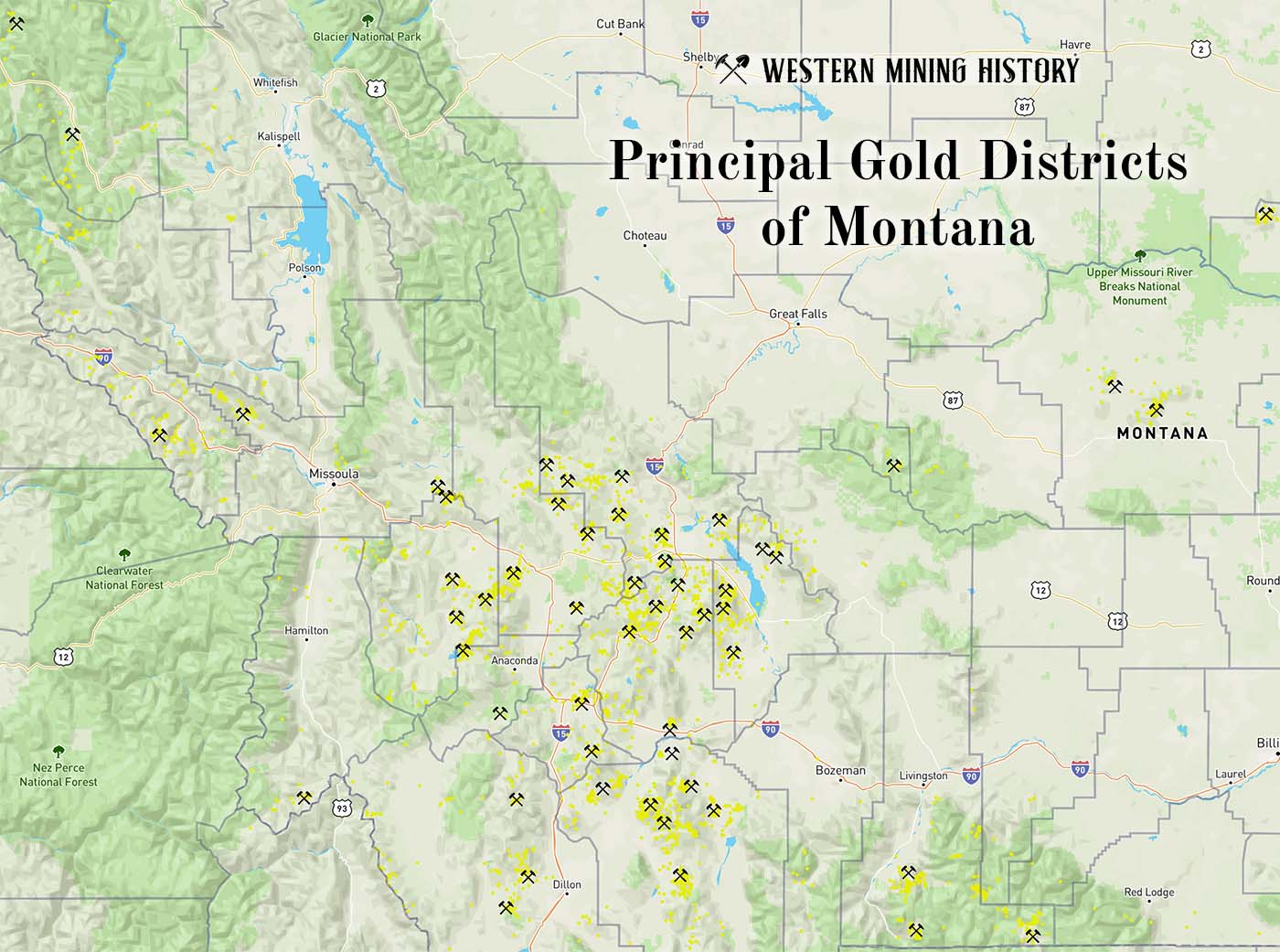The Philipsburg is a silver and manganese mine located in Granite county, Montana.
About the MRDS Data:
All mine locations were obtained from the USGS Mineral Resources Data System. The locations and other information in this database have not been verified for accuracy. It should be assumed that all mines are on private property.
Mine Info
Philipsburg MRDS details
Site Name
Primary: Philipsburg
Commodity
Primary: Silver
Primary: Manganese
Secondary: Phosphorus-Phosphates
Secondary: Lead
Secondary: Gold
Secondary: Copper
Secondary: Iron
Tertiary: Tungsten
Tertiary: Cobalt
Tertiary: Arsenic
Tertiary: Antimony
Location
State: Montana
County: Granite
District: Philipsburg (Granite-Flint Creek) District
Land Status
Not available
Holdings
Not available
Workings
Not available
Ownership
Not available
Production
Year: 1962
Time Period: 1904-1962
Material type: PB
Description: Cp_Grade: ^90% Ag
Deposit
Record Type: Site
Operation Category: Producer
Operation Type: Unknown
Years of Production:
Organization:
Significant: N
Deposit Size: S
Physiography
General Physiographic Area: Rocky Mountain System
Physiographic Province: Northern Rocky Mountains
Mineral Deposit Model
Not available
Orebody
Not available
Structure
Not available
Alterations
Not available
Rocks
Name: Diorite
Role: Associated
Age Type: Associated Rock
Age Young: Late Cretaceous
Name: Diorite
Role: Associated
Age Type: Associated Rock Unit
Age Young: Late Cretaceous
Analytical Data
Not available
Materials
Ore: Silver
Ore: Cerargyrite
Ore: Chlorargyrite
Ore: Tetrahedrite
Ore: Psilomelane
Ore: Argentite
Ore: Galena
Ore: Magnetite
Ore: Powellite
Ore: Scheelite
Ore: Tremolite
Ore: Chalcopyrite
Ore: Gold
Ore: Sphalerite
Ore: Pyrolusite
Gangue: Barite
Gangue: Pyrite
Gangue: Rhodochrosite
Gangue: Quartz
Gangue: Calcite
Comments
Comment (Deposit): DEPOSITS ARE DIVIDED INTO 5 GROUPS: (1) STEEPLY DIPPING QUARTZ VEINS, (2) QUARTZ VEINS ALONG BEDDING, (3) MANGANESE-RICH REPLACEMENT DEPOSITS, (4) CONTACT METASOMATIC MAGNETITE DEPOSITS, AND (5) SEDIMENTARY PHOSPHATE BEDS. THE STEEPLY DIPPING QUARTZ VEINS ARE FISSURE VEINS WHICH CUT BOTH THE BATHOLITH AND SEDIMENTARY ROCKS AND WERE MINED FOR AG, ZN AND PB. THE BEDDING PLANE QUARTZ VEINS ARE COMMON IN THE N PART OF THE DISTRICT. THESE VEINS HAVE YIELDED MUCH HIGH GRADE AG. REPLACEMENT DEPOSITS RICH IN MANGANESE ARE IRREGULARLY DISTRIBUTED IN FAVORABLE HOST BEDS ALONG MANY STEEPLY DIPPING QUARTZ VEINS, THE BORDER OF THE BATHOLITH, AND THE REDEMPTION FAULT. THE PHOSPHATE BEDS CROP OUT ON THE W FLANK OF THE BROAD PHILIPSBURG ANTICLINE. THE CONTACT METASOMATIC IRREGULAR MAGNETITE PODS OCCUR IN MARBLE ALONG THE BORDER OF THE BATHOLITH AND ALONG A PREINTRUSION HIGH-ANGLE REVERSE FAULT.
Comment (Geology): THE STEEPLY DIPPING QUARTZ VEINS IN THE SEDIMENTARY ROCKS ARE THE LARGEST AND MOST PRODUCTIVE IN A BELT 2000 FT WIDE THAT TRENDS N15-20W AND CROSSES THE CREST OF THE PHILIPSBURG ANTICLINE. THE BEDDING PLANE QUARTZ VEINS IN THE N PART OF THE DISTRICT ARE DIVIDED INTO 2 GROUPS THAT ARE SEPARATED BY 400 FT INTERVAL OF BARREN ROCKS. HASMARK MARBLE, HEADLIGHT BED, LIMESTONE BEDS IN THE MIDDLE OF THE SILVER HILL FM, JEFFERSON MARBLE, AND LIMESTONE BEDS IN THE MAYWOOD FM ARE FAVORABLE FOR THE REPLACEMENT DEPOSITS RICH IN MANGANESE. THE MAGNETITE DEPOSITS CAN BE FOUND IN THE MARBLE OF THE HASMARK FM AND IN THE SW PART OF THE DISTRICT.
Comment (Reserve-Resource): UNKNOWN; PROBABLY UNIMPORTANT FOR COBALT.
Comment (Production): AMOUNT OF PRODUCTION UNKNOWN
Comment (Development): THE AG PRODUCTION STARTED WITH THE HOPE MINE. FIRST RECORDED PRODUCTION OF MN WAS IN 1900, BUT THE DEMAND WAS NOT MAJOR UNTIL 1913.
Comment (Deposit): ONLY ONE CO ANALYSIS: CRYPTOMELANE CARRIES 0.08% CO OXIDE; MORE ASSAYS OF MANGANESE OXIDES SHOULD BE MADE FOR COBALT.
References
Reference (Deposit): USGS PP 78, P. 201-20.
Reference (Deposit): USGS PP 610, P. 151-52.
Reference (Deposit): MBMG BULL 30, P. 21.
Reference (Deposit): USGS BULL 1237.
Reference (Deposit): USBM RI 6611, P. 56-73.
Reference (Deposit): USBM RI 5612, P. 20-3.
Reference (Deposit): USGS BULL 922-G, P. 147-57.
Reference (Production): USGS BULL 1237; USGS-USBM MINERAL YEARBOOKS.
Reference (Reserve-Resource): UNPUBLISHED COBALT REPORT
Principal Gold Districts of Montana

In Montana, 54 mining districts have each have produced more than 10,000 ounces of gold. The largest producers are Butte, Helena, Marysville, and Virginia City, each having produced more than one million ounces. Twenty seven other districts are each credited with between 100,000 and one million ounces of gold production. Read more: Principal Gold Districts of Montana.